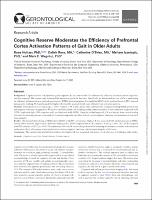Please use this identifier to cite or link to this item:
https://hdl.handle.net/20.500.12202/9368| Title: | Cognitive reserve moderates the efficiiency of prefrontal cortex activation patterns of gait in older adults |
| Authors: | Holtzer, Roee Ross, Daliah O’Brien, Catherine Izzetoglu, Meltem Wagshul, Mark E 0000-0001-6639-0724 |
| Keywords: | Cognitive reserve Gait Neural efficiency Prefrontal cortex |
| Issue Date: | 2021 |
| Publisher: | Oxford UP |
| Citation: | Holtzer, R., Ross, D., O’Brien, C., Izzetoglu, M., & Wagshul, M. E. (2021). Cognitive reserve moderates the efficiiency of prefrontal cortex activation patterns of gait in older adults. The Journals of Gerontology: Series A, glab288. https://doi.org/10.1093/gerona/glab288 |
| Series/Report no.: | The Journals of Gerontology: Series A;77(9) |
| Abstract: | Abstract Background Cognitive reserve (CR) protects against cognitive decline, but whether CR influences the efficiency of cortical control of gait has not been reported. The current study addressed this important gap in the literature. Specifically, we determined the role of CR in moderating the efficiency of functional near-infrared spectroscopy (fNIRS)-derived oxygenated hemoglobin (HbO2) in the prefrontal cortex (PFC) assessed during active walking. We hypothesized that higher CR would be associated with more efficient brain activation patterns. Methods Participants were 55 (mean age = 74.84; %female = 49.1) older adults who underwent the combined walking/fNIRS protocol and had magnetic resonance imaging data. We used an established dual-task walking paradigm that consisted of 3 task conditions: single-task walk (STW), single-task alpha (STA, cognitive task), and dual-task walk (DTW). Using the residual approach, CR was derived from a word-reading test score by removing variance accounted for by sociodemographic variables, tests of current cognitive functions, and a measure of structural brain integrity. Results CR moderated the change in fNIRS-derived HbO2 in the PFC across tasks. Higher CR was associated with smaller increases in fNIRS-derived HbO2 from the single tasks to dual-task walking (CR × DTW compared with STW: estimate = 0.183; p < .001; CR × DTW compared with STA: estimate = 0.257; p < .001). The moderation effect of CR remained significant when adjusting for multiple covariates and concurrent moderation effects of measures of gait performance, current cognitive functions, and structural integrity of the brain. Conclusion The current study provided first evidence that higher CR was associated with better neural efficiency of walking in older adults. |
| Description: | Scholarly article / Open access |
| URI: | https://academic.oup.com/biomedgerontology/article/77/9/1836/6380752 https://hdl.handle.net/20.500.12202/9368 |
| ISSN: | 1758-535X |
| Appears in Collections: | Ferkauf Graduate School of Psychology: Faculty Publications |
Files in This Item:
| File | Description | Size | Format | |
|---|---|---|---|---|
| Holtzer 2021 OA Cognitive reseserve.pdf | 407.12 kB | Adobe PDF |  View/Open |
This item is licensed under a Creative Commons License

